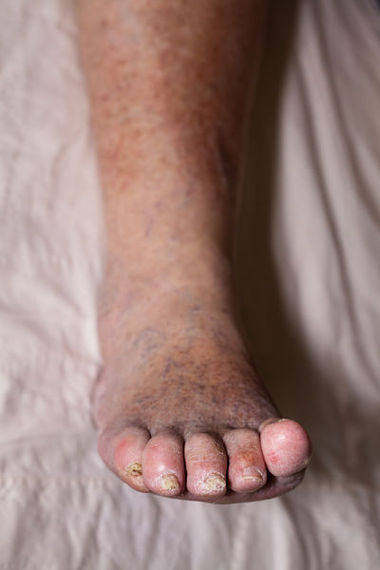A co-worker of mine developed diabetes but had no idea how bad his condition was until one day at work he stepped on a thumb tac and didn’t feel it until someone pointed out that a tac was stuck to his shoe. Upon closer inspection he noticed that his foot was indeed bleeding but he had no pain sensation.
John was a very active person . . . . not just around the office but also in school where he played basketball for his college team.
It was devastating news when we learned that he had to have amputation –first a toe and then the foot and eventually most of his lower leg.
At the first sign of neuropathy – tingling sensation or numbness – in your leg visit with your doctor. They can recommend as to the next steps to take. If you plan on exercising, wear comfortable shoes and socks and check your feet regularly for blisters or bruises.
The following article by Milt Bedingfield (Author, Prescription for Type 2 Diabetes: Exercise. Exercise Physiologist and Certified Diabetes Educator) talks more about neuropathy and how to deal with it.
Type 2 Diabetes and Peripheral Neuropathy: To Walk or Not to Walk?
It is now well-known that engaging in light to moderate physical activity on a regular basis is of significant value for most people who have either Type 1 or Type 2 diabetes. In fact the American Diabetes Association recommends that people with diabetes should get a minimum of 150 minutes of light to moderate exercise per week including aerobic and resistance training.
What the ADA says…
It has also been recommended that people with peripheral diabetic neuropathy that have reduced or absent feeling in their feet should not engage in any form of weight-bearing exercise activity. The American Diabetes Association recommends that people with diabetes-related peripheral neuropathy should limit the amount of weight-bearing physical activity they perform due to their increased risk of foot ulcers and amputation (1, 2). This is based on the fact that with peripheral neuropathy there is either a decreased ability or total inability in the feet to feel pain or discomfort.
As an example, standing barefoot on hot asphalt maybe in a parking lot in the middle of the summer would be very uncomfortable for someone with normal sensation in their feet, however go unnoticed for someone with peripheral neuropathy. Similarly, the person with peripheral neuropathy may develop a painful nickel-sized blister after walking too far or when wearing new shoes and not even feel it. Without daily inspection of the ankles and feet (which a lot of people do not do) this blister could go unnoticed for days resulting in a potentially infected, slow to heal, or non-healing wound. In the worst case this could lead to an amputation. All of this is the result of losing what is called the protective sensation in the feet.
In the absence of peripheral neuropathy when there is insult to the foot or feet such as a blister, a cut or scrape or stepping on a small piece of glass or nail, there would be pain which would cause you to notice the injury and hopefully treat the wound accordingly.
There are also painful stages of neuropathy that can precede lack of sensation which are characterized by frequent but intermittent pain in the feet throughout the day, having pain only in the evening while in bed to constant pain. This stage of neuropathy can result in changing the way you walk, that is your stride length, which part of your feet you strike the ground with first and ultimately what part of your feet support your body weight.
Because of everything I have just mentioned above this leads to the unfortunately recommendation that discourages walking for a great many people with diabetes.
To Walk or Not to Walk?
So where does that leave us? Exercise is arguably the best treatment there is, particularly in controlling Type 2 diabetes, and preventing diabetes related complications, such as peripheral neuropathy, however once you have peripheral neuropathy in your feet you should avoid doing any weight-bearing exercise.
I have wrestled with the dilemma for years about how to guide my patients that would benefit immensely from starting to exercise or increasing their exercise however have various stages of neuropathy.
According to the Centers for Disease Control and Prevention, from 2000-2002, approximately 60 percent of lower-extremity amputations in the United States were diabetes-related, with the majority of those amputations being preceded by a foot ulcer (3). Almost all diabetic foot ulcers occur in those people who have lost feeling in their feet due to diabetic peripheral neuropathy (4, 5).
On the other hand poorly controlled blood glucose control contributes greatly to peripheral neuropathy.
Eight-year cardiovascular mortality is 34 percent lower among people with diabetes who walk two hours per week compared with non-walkers (6).
Feet First Randomized Controlled Trial
The Feet First Randomized Controlled Trial was designed to look at the effect of weight-bearing activity on foot ulcer incidence in people with diabetic peripheral neuropathy. The study, conducted over a 12-month period by Lemaster and colleagues, showed that participants in the Feet First intervention group achieved a modest increase in activity, with no increase in foot lesions, compared with those in the control group. The group also recommended additional research be conducted in this area to investigate the current guidelines and close supervision for patients with diabetes and peripheral neuropathy (7).
Tuttle and colleagues found that people with Type 2 diabetes and peripheral neuropathy experienced no negative consequences when performing moderate-intensity, weight-bearing exercise in their study (2).
Dr. Sheri Colberg reports in her article “Exercising with Peripheral Neuropathy” that recent descriptive studies suggest that patients with a lack of feeling in their feet who participate in daily weight-bearing activity are at decreased risk of foot ulceration compared with those who are less active (8, 9), especially if their daily routine is very similar with little variation from day-to-day regarding their physical activity (9, 10).
As a result of the above information, I am going to continue evaluating each of my class participants on a case by case basis, however, for those patients with peripheral neuropathy that I believe will be prudent in checking their feet and following the recommended foot care guidelines and stand to gain significant benefit from performing some weight-bearing exercise, I will be more likely to recommend it to them.
You can view the original post here
P.S. If you have diabetes it’s important that you start a proper workout routine to include stretching, cardio and resistance. You can participate in sporting events . . . however if you develop peripheral neuropathy you may be limited to the types of activities in which you can participate. Get clearance from your doctor who can advise you on the types of exercises to do.
P.P.S. Visit How to prevent pre-diabetes where you will find information on a variety of exercises to help with neuropathy.






